The ADATA Ultimate SU750 1TB SSD Review: Realtek Does Storage, Part 1
by Billy Tallis on December 6, 2019 8:00 AM ESTSequential Read Performance
Our first test of sequential read performance uses short bursts of 128MB, issued as 128kB operations with no queuing. The test averages performance across eight bursts for a total of 1GB of data transferred from a drive containing 16GB of data. Between each burst the drive is given enough idle time to keep the overall duty cycle at 20%.
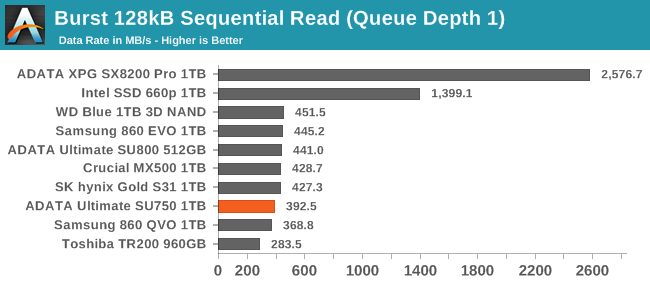
The burst sequential read performance from the ADATA Ultimate SU750 is a little bit slower than the mainstream SATA drives, but it's ahead of the other two entry-level drives.
Our test of sustained sequential reads uses queue depths from 1 to 32, with the performance and power scores computed as the average of QD1, QD2 and QD4. Each queue depth is tested for up to one minute or 32GB transferred, from a drive containing 64GB of data. This test is run twice: once with the drive prepared by sequentially writing the test data, and again after the random write test has mixed things up, causing fragmentation inside the SSD that isn't visible to the OS. These two scores represent the two extremes of how the drive would perform under real-world usage, where wear leveling and modifications to some existing data will create some internal fragmentation that degrades performance, but usually not to the extent shown here.
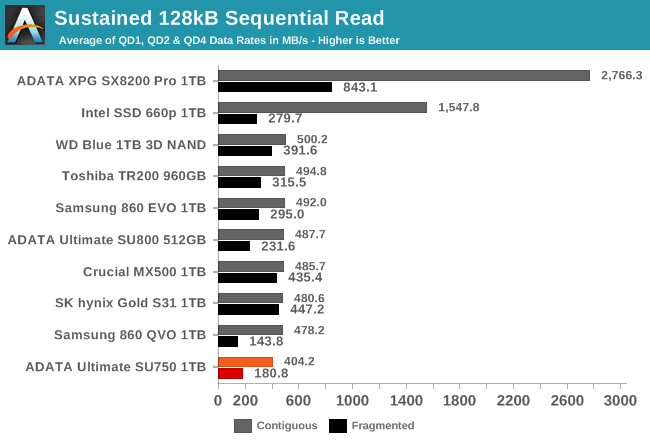
On the longer sequential read test, the SU750 is in last place and about 15% slower than the 860 QVO, though when reading back data that was written out of order, the 860 QVO is worse. The DRAMless Toshiba TR200 does well in both cases.
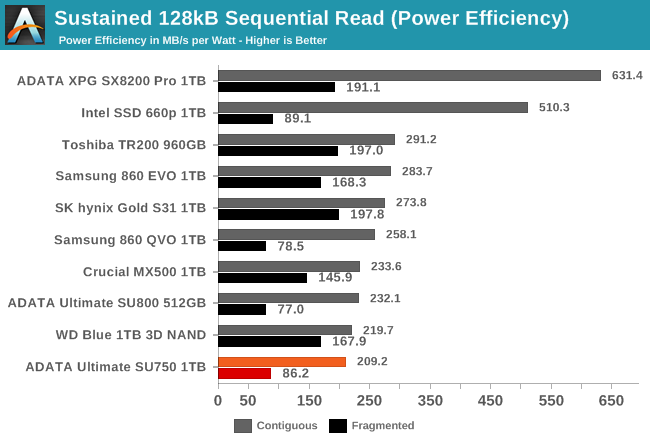 |
|||||||||
| Power Efficiency in MB/s/W | Average Power in W | ||||||||
The power efficiency scores from the SU750 are again among the lowest, but unlike the random IO tests it isn't a big outlier in terms of either efficiency or total power draw.
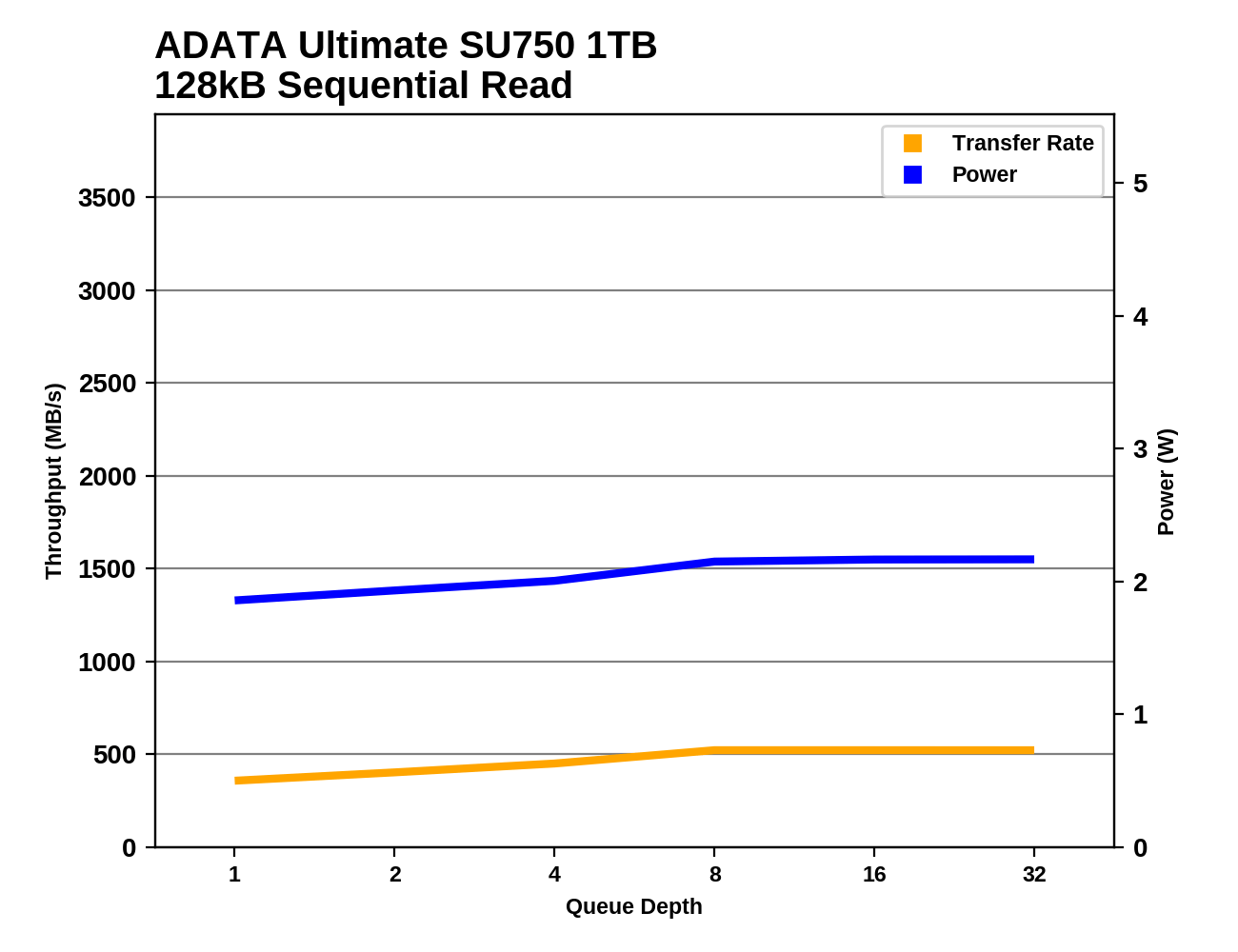 |
|||||||||
The SU750 does eventually reach sequential read speeds that more or less saturate the SATA link, but it requires a higher queue depth than any of the other drives in this batch. Power consumption is consistently just a bit higher than typical for mainstream drives, so at high queue depths its efficiency scores wouldn't be as bad as the low-QD scores shown above.
The SU750's sequential read speed at QD1 is definitely one of the slowest results we've seen, but at higher queue depths it is adequately fast and its power consumption is merely above-average and doesn't stand out from the crowd.
Sequential Write Performance
Our test of sequential write burst performance is structured identically to the sequential read burst performance test save for the direction of the data transfer. Each burst writes 128MB as 128kB operations issued at QD1, for a total of 1GB of data written to a drive containing 16GB of data.
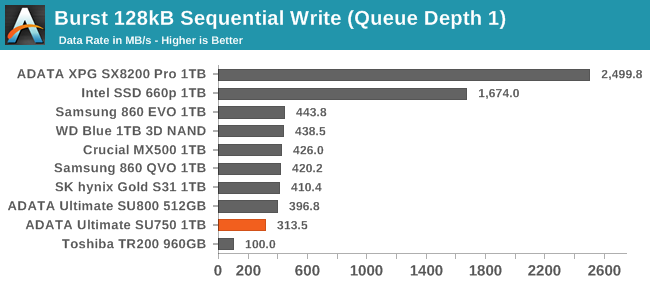
The burst sequential write performance of the SU750 is clearly slower than mainstream SATA drives, but is nowhere near as bad as the Toshiba TR200's sub-HDD result.
Our test of sustained sequential writes is structured identically to our sustained sequential read test, save for the direction of the data transfers. Queue depths range from 1 to 32 and each queue depth is tested for up to one minute or 32GB, followed by up to one minute of idle time for the drive to cool off and perform garbage collection. The test is confined to a 64GB span of the drive.
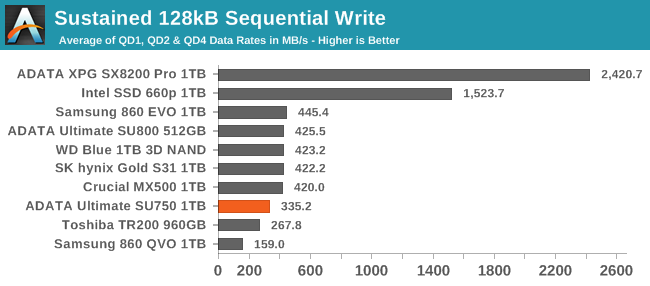
On the longer sequential write test that brings in some higher queue depths, the SU750 falls a little further behind the mainstream SATA drives, and the Samsung 860 QVO crashes down to last place while the Toshiba TR200 starts to catch up with the SU750.
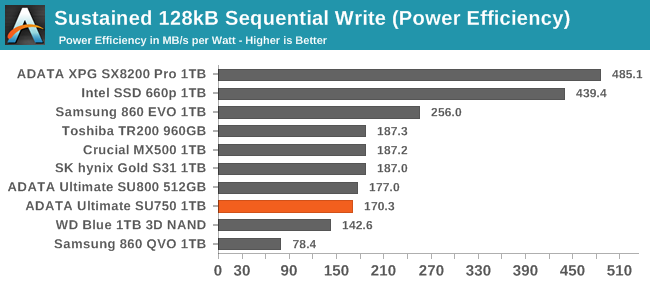 |
|||||||||
| Power Efficiency in MB/s/W | Average Power in W | ||||||||
The power efficiency score for the SU750 during the sequential write test is not bad, for a change. The absolute power consumption is lower than most of the other drives, and the performance is good enough to make for decent efficiency.
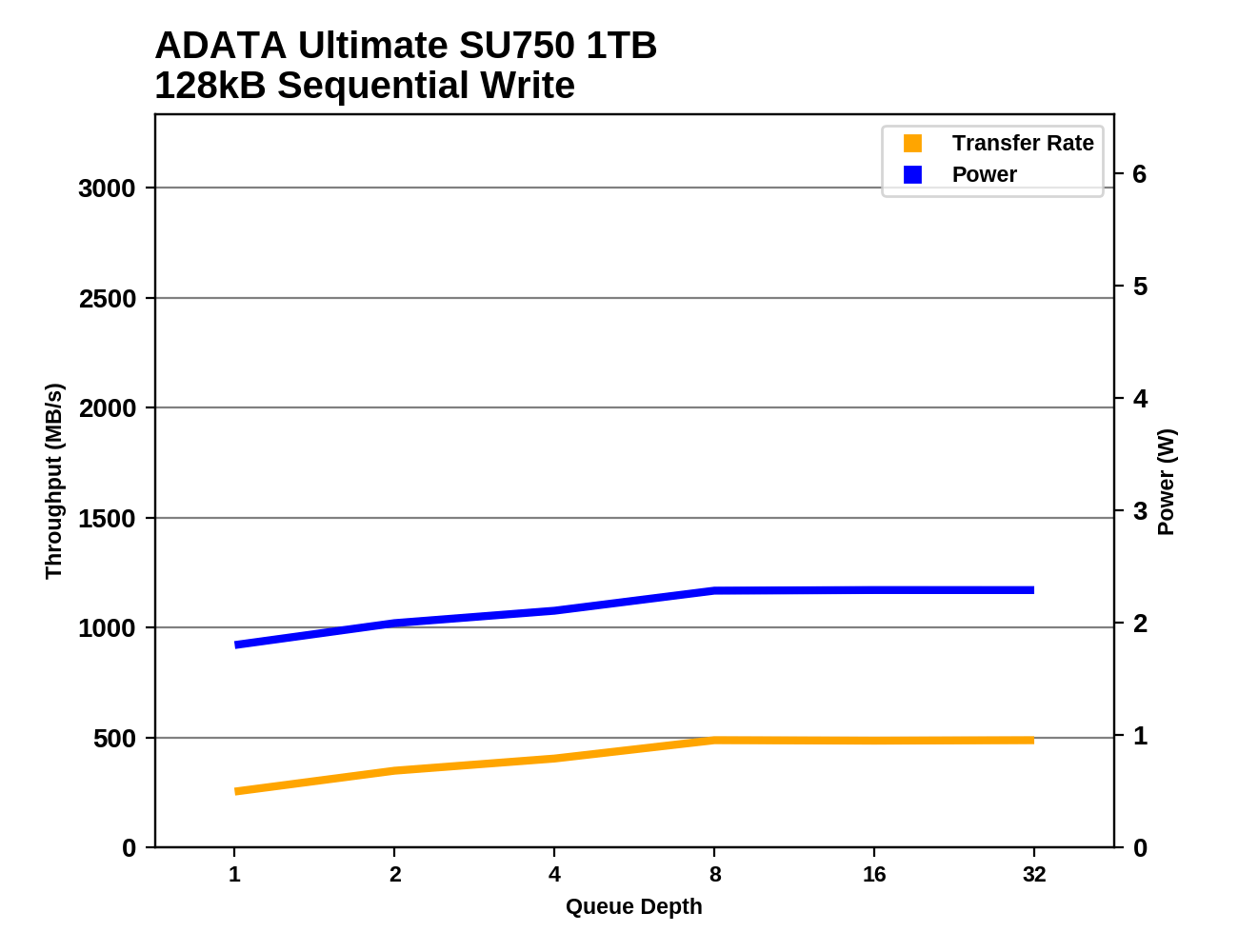 |
|||||||||
As with the sequential read test, the SU750 needs a fairly high queue depth to reach its full sequential write performance, which is competitive with mainstream SATA drives. It retains that performance for the rest of the test.
The low-QD sequential write performance from the SU750 could certainly be a lot worse, judging by some of the results from our archive. Across its entire speed range, the power consumption of the SU750 seems to be a bit below average, but never low enough to translate into impressive efficiency.












54 Comments
View All Comments
sonny73n - Friday, December 6, 2019 - link
Realtek does audioRealtek does networking
Realtek does storage
Debbie does Dallas
RadiclDreamer - Friday, December 6, 2019 - link
Realtek may do all of these things, but it does them all poorly.FunBunny2 - Friday, December 6, 2019 - link
"Realtek may do all of these things, but it does them all poorly."Debbie wasn't so hot either. :):)
boozed - Friday, December 6, 2019 - link
I don't know that I'd call them poor. Good value, reliable (in my experience) and good enough for the vast majority of users.Other options are available for enthusiasts.
eek2121 - Friday, December 6, 2019 - link
The trouble is that you are talking about a few dollars for a much faster and more power efficient drive. This controller appears DOA as it brings nothing unique to the table.Samus - Saturday, December 7, 2019 - link
With what Intel charges for network controllers, it’s astonishing Realtek is in business when you consider how superior an Intel NIC is while being a few dollars more. And wireless is a whole different story. I’d put Realtek at the absolute bottom of the list. Atheros/Qualcomm, Intel, Agere, Lucent, Broadcom, all have better reliability, support (which is shocking when you consider how vastly used Realtek products are) and generally - performance, than competing Realtek solutions.I think where Realtek scores is availability. Their volume shows commitment to OEM’s that require dependable shipping schedules. This can be as important is BOM pricing, and when you look at the numbers, it seems (and I’m speculating) Realtek designs products for volume production more than anything else. The incredibly low pin count and a 2 channel controller back this up. We are talking about possibly the most basic SATA SSD controller in production and that means they will be able to make a shitload of them really fast really cheap.
And unfortunately OEMs will bite because they know 90% of the people buying this crap don’t care about the inner margin performance of an SSD. Most people buy on price, reliability and warranty.
This shitty SSD May have all 3 bases covered considering the quality binning of Micron NAND.
close - Saturday, December 7, 2019 - link
"a few dollars more" adds up when buying by the truckload. With millions of devices that have a network chipset that's quite some money.jabber - Sunday, December 8, 2019 - link
Yeah amazing how many people don't realise how shaving just 50 cents off a product that will sell hundreds of thousands to millions will save a company a fortune and help with profit.A good example is to watch the documentary "Building a Faster Horse" on how Ford designed and built the 2016 iirc Ford Mustang. Every single part and component was scrutinised to see if it could be either removed/simplified or made cheaper.
That's why Realtek exists still. Their parts are 50c cheaper than Intels.
Manch - Monday, December 9, 2019 - link
Ford been making the Mustang cheaper and cheaper while charging more and more. Started with the Getrag MT-82 grenade and got worse with the crap IRS, corner cutting everywhere. Add on top of it a horrid design (Looks like a 2 door Focus) and they wonder why they're losing customers.hanselltc - Saturday, December 7, 2019 - link
Killer